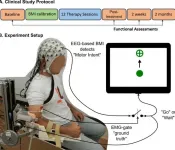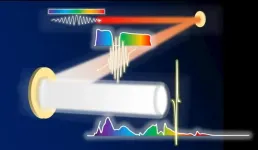Tapping the brain to boost stroke rehabilitation
Clinical trial suggests brain-machine interface coupled with robot offers increased benefits for stroke survivors
2021-01-12
(Press-News.org) Stroke survivors who had ceased to benefit from conventional rehabilitation gained clinically significant arm movement and control by using an external robotic device powered by the patients' own brains.
The results of the clinical trial were described in the journal NeuroImage: Clinical.
Jose Luis Contreras-Vidal, director of the Non-Invasive Brain Machine Interface Systems Laboratory at the University of Houston, said testing showed most patients retained the benefits for at least two months after the therapy sessions ended, suggesting the potential for long-lasting gains. He is also Hugh Roy and Lillie Cranz Cullen Distinguished Professor of electrical and computer engineering.
The trial involved training stroke survivors with limited movement in one arm to use a brain-machine interface (BMI), a computer program that captures brain activity to determine the subject's intentions and then triggers an exoskeleton, or robotic device affixed to the affected arm, to move in response to those intentions. The device wouldn't move if intention wasn't detected, ensuring subjects remained engaged in the exercise.
Using robotics in rehabilitation isn't new, said Contreras-Vidal, co-principal investigator of the trial and a pioneer in noninvasive BMI systems. But robot-assisted exercise doesn't generally engage the user, which is critical for taking advantage of the brain's plasticity to allow patients to relearn movement.
"This project ensures the brain is engaged," he said. "We know that if the arm is moving, it's because they are commanding it to move. That's a very powerful concept."
By testing the subjects over a period of time before the trial began, researchers were able to ensure that any changes or improvements were due to the intervention. In addition to better arm movement, the researchers reported that the subjects also showed improvements in using their hands.
"This is a novel way to measure what is going on in the brain in response to therapeutic intervention," said Dr. Gerard Francisco, professor and chair of physical medicine and rehabilitation at McGovern Medical School at The University of Texas Health Science Center at Houston and co-principal investigator. "This study suggested that certain types of intervention, in this case using the upper robot, can trigger certain parts of brain to develop the intention to move. In the future, this means we can augment existing therapy programs by paying more attention to the importance of engaging certain parts of the brain that can magnify the response to therapy."
The trial was conducted at TIRR Memorial Hermann, where Francisco serves as chief medical officer and director of the NeuroRecovery Research Center. The project was a collaboration between UH, UTHealth, TIRR Memorial Hermann, Houston Methodist Research Institute and Rice University.
In addition to Francisco and Contreras-Vidal, who is also director of the BRAIN Center, a NSF Industry/University Collaborative Research Institute, researchers involved with the project include Nikunj A. Bhagat and Zachary Hernandez with UH; Nuray Yozbatiran and Rupa Paranjape with UTHealth; Dr. Zafer Keser, formerly with UTHealth; Jennifer L. Sullivan, Colin Losey and co-principal investigator Marcia K. O'Malley with Rice; and Dr. Robert Grossman with Houston Methodist Research Institute. O'Malley is also Director of Rehabilitation Engineering at TIRR Memorial Hermann.
It was funded by the National Institute of Neurological Disorders and Stroke and Mission Connect, part of the TIRR Foundation.
"Those of us who have studied the brain for so many years have anticipated that its powers, combined with robotics and the brain-machine interface, could offer unimaginable benefits to stroke survivors and other patients with brain injuries," said Grossman, professor of neurosurgery at Houston Methodist. "This study is just the beginning of what will be possible to treat stroke, spinal cord injuries and other traumatic brain injuries in the future."
The trial spanned a period of several years, partly because it took time to find subjects who met the criteria and were both interested in participating and able to make the required time commitment. Ultimately, 10 subjects between the ages of 41 and 71 were enrolled.
The therapy took place three times a week for four weeks. The final follow-up testing was conducted two months after therapy ended, and Contreras-Vidal said it's unclear if the benefits will persist long-term.
That leads to an ongoing project - Contreras-Vidal has a National Science Foundation grant to design a low-cost system that would allow people to continue the treatments at home.
"If we are able to send them home with a device, they can use it for life," he said.
INFORMATION:
[Attachments] See images for this press release:

ELSE PRESS RELEASES FROM THIS DATE:
2021-01-12
GAINESVILLE, Fla. --- Entomologist Akito Kawahara's message is straightforward: We can't live without insects. They're in trouble. And there's something all of us can do to help.
Kawahara's research has primarily focused on answering fundamental questions about moth and butterfly evolution. But he's increasingly haunted by studies that sound the alarm about plummeting insect numbers and diversity.
Kawahara has witnessed the loss himself. As a child, he collected insects with his father every weekend, often traveling to a famous oak outside Tokyo ...
2021-01-12
MANHATTAN, KANSAS -- Kyle Goerl, the medical director of Kansas State University's Lafene Health Center, is part of a collaborative team that is providing research-based guidance during the COVID-19 pandemic. The team's latest research contributed to the updated quarantine guidance from the Centers for Disease Control and Prevention.
Goerl is a co-author of the publication "Time from Start of Quarantine to SARS-CoV-2 Positive Test Among Quarantined College and University Athletes." The publication appeared in the Morbidity and Mortality Weekly Report from the CDC on Friday, Jan. 8, and involved researchers from multiple organizations and universities.
The publication was one of many that the ...
2021-01-12
Osaka, Japan -- Ultra-intense lasers with ultra-short pulses and ultra-high energies are powerful tools for exploring unknowns in physics, cosmology, material science, etc. With the help of the famous technology "Chirped Pulse Amplification (CPA)" (2018 Nobel Prize in Physics), the current record has reached 10 Petawatts (or 10^16 Watts). In a study recently published in Scientific Reports, researchers from Osaka University proposed a concept for next-generation ultra-intense lasers with a simulated peak power up to the Exawatt class (1 Exawatt equals 1000 Petawatts).
The laser, which was invented by Dr. T. H. Maiman in 1960, has one important characteristic of high intensity (or high peak power for pulse lasers): historically, laser peak ...
2021-01-12
Scientists at Nanyang Technological University, Singapore (NTU Singapore) have developed insulin nanoparticles that may one day become the basis for an oral medicine, and an alternative to insulin injections for diabetic patients.
In a pre-clinical study, the NTU Singapore team fed insulin-containing nanoparticles to rats and found that insulin increased in their blood minutes later.
Insulin therapy is often an important part of treatment for diabetes, a metabolic disease that affects 422 million people globally . In Singapore, the number of diabetics is expected to grow to 1 million - almost a fifth of the population - in 2050 .
Delivering insulin orally would be preferable over insulin jabs for patients because it causes less ...
2021-01-12
Anthropogenic, or human-made, heat flux in the near-surface atmosphere has changed urban thermal environments. Much of this fluctuation has been noted with rapid development of the global economy and urbanization since the turn of the 21st century. Meanwhile, the number of extreme temperature events in the first decade of the 21st century grew faster than in the last 10 years of the 20th century. During this period, urban extreme heat events have become more frequent, breaking temperature records more often.
"We found the relationships between anthropogenic heat flux and extreme temperature events..." said Prof. Zhenghui Xie, a scientist with the Institute of Atmospheric Physics, Chinese Academy of Sciences. "...including ...
2021-01-12
DALLAS - Jan. 12, 2021 - A team of UT Southwestern researchers has identified a gene involved in the growth of breast cancer, a finding that could lead to potential new targets for treatment.
"The gene ZMYND8 is increased in breast cancer conditions, and higher levels of the gene correlate with poor survival of breast cancer patients," says Yingfei Wang, Ph.D., assistant professor of pathology and neurology and corresponding author of the new study, published in Cancer Research. "It could be a promising target for antitumor immunotherapy."
In the U.S., about 1 in 8 women will develop breast cancer at some point in their life. Worldwide, breast cancer is the most common cancer ...
2021-01-12
In a paper published in Molecular Frontiers Journal, researchers from Cambridge, Massachusetts and Bangalore, India study the effectiveness of FEND product to significantly improve airway hygiene by reducing and suppressing respiratory droplets potentially containing airborne pathogens and other contaminants. The study's findings further highlight why the FEND product is an important new daily hygiene protocol that joins century-old hand washing, masking and distancing measures as a fourth protective layer of defense against aerosolized particles.
The new study examined two nasal salines: ...
2021-01-12
CORVALLIS, Ore. - A resemblance to moss, lichens and fungi made for fantastic cover by a new genus and species of cylindrical bark beetle described by an Oregon State University College of Science researcher.
"If you can't beat your enemies or run away, then hide, and that is what this Cretaceous beetle is doing," said OSU's George Poinar Jr. "He is hiding under a spectacular camouflage of his own making, allowing him to blend into a mossy background."
Poinar, an international expert in using plant and animal life forms preserved in amber to learn more about the biology and ecology of the distant past, and collaborator Fernando ...
2021-01-12
Research on cycad trees in Colombia, Guam, and the Philippines has illuminated how knowledge of their branching behavior may benefit conservation decisions for the endangered plants. In a study published in the December issue of the journal Horticulturae, scientists from the University of Guam and the Montgomery Botanical Center in Florida show that the number of times a cycad tree produces a branch can be used to infer the sex of the tree. The findings have practical applications for use of the sexual dimorphism that is described.
Cycads are unique seed-producing plants. Conservation actions are being implemented for many species around the world as cycads are being threatened by human activity.
The arborescent cycad stem is constructed using ...
2021-01-12
Ten years of data from Australia, New Zealand and Canada reveals a drop in drowning deaths among people under 20 - but a large increase in drowning for adolescent females and First Nations peoples.
Associate Professor Richard Franklin from James Cook University in Queensland, Australia, said an international collaboration of researchers looked at drowning in the under 20s between 2005 and 2014.
"Globally, drowning is a leading cause of unintentional death among children and young people, with the greatest toll among children under the age of five years. Many more children are impacted by non-fatal drowning, some experiencing long-term health impacts," said Dr Franklin.
He said children aged 0-19 years account for an average ...
LAST 30 PRESS RELEASES:
[Press-News.org] Tapping the brain to boost stroke rehabilitation
Clinical trial suggests brain-machine interface coupled with robot offers increased benefits for stroke survivors








